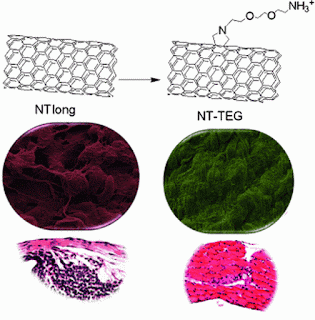Asbestos-like Pathogenicity of Long Carbon Nanotubes Alleviated by Chemical Functionalization.
Safety fears about carbon nanotubes, due to their structural similarity to asbestos, have been alleviated following research showing that reducing their length removes their toxic properties.
In a new study, published today in the journal Angewandte Chemie, evidence is provided that the asbestos-like reactivity and pathogenicity reported for long, pristine nanotubes can be completely alleviated if their surface is modified and their effective length is reduced as a result of chemical treatment.
First atomically described in the 1990s, carbon nanotubes are sheets of carbon atoms rolled up into hollow tubes just a few nanometres in diameter. Engineered carbon nanotubes can be chemically modified, with the addition of chemotherapeutic drugs, fluorescent tags or nucleic acids – opening up applications in cancer and gene therapy.
Furthermore, these chemically modified carbon nanotubes can pierce the cell membrane, acting as a kind of 'nano-needle', allowing the possibility of efficient transport of therapeutic and diagnostic agents directly into the cytoplasm of cells.
Among their downsides however, have been concerns about their safety profile. One of the most serious concerns, highlighted in 2008, involves the carcinogenic risk from the exposure and persistence of such fibres in the body. Some studies indicate that when long untreated carbon nanotubes are injected to the abdominal cavity of mice they can induce unwanted responses resembling those associated with exposure to certain asbestos fibres.
We are among the world's top universities, as reflected by our performance in a range of international rankings and tables. According to the Thomson Scientific Citation Index, UCL is the second most highly cited European university and the 15th most highly cited in the world.
UCL has nearly 25,000 students from 150 countries and more than 9,000 employees, of whom one third are from outside the UK. The university is based in Bloomsbury in the heart of London, but also has two international campuses – UCL Australia and UCL Qatar. Our annual income is more than £800 million.
Contact: Clare Ryan clare.ryan@ucl.ac.uk 44-020-310-83846 University College London
For more information, please contact Professor Kostas Kostarelos on tel: +44 (0)207 753 5956, email: k.kostarelos@ucl.ac.uk











No comments:
Post a Comment